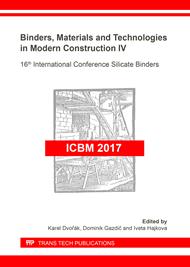p.3
p.9
p.15
p.21
p.27
p.35
p.41
p.47
Hydraulic Binder from Hazardous Waste
Abstract:
Since asbestos has been classified as a hazardous chemical, it is desirable to propose a practical and safe procedure for the disposal of asbestos-cement products, or even better to re-use them. In this work, the temperature conditions of degradation of samples of various types of asbestos and products containing asbestos were examined. Samples were burnt at different temperatures and monitored by XRD, DTA, light and electron microscopy. By evaluation of changes at different burning temperatures, the previous findings on the decomposition of asbestos minerals have been confirmed. It has been found that the burning of asbestos cement materials alone or with the addition of limestone at the temperature above 1100 °C leads to the decomposition of hazardous asbestos and, with or without the addition of a setting regulator, hydraulic binder is formed with technological parameters suitable for the building industry.
Info:
Periodical:
Pages:
3-8
Citation:
Online since:
June 2018
Authors:
Keywords:
Price:
Сopyright:
© 2018 Trans Tech Publications Ltd. All Rights Reserved
Share:
Citation:


